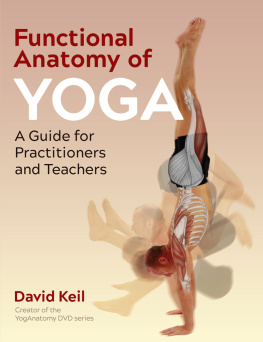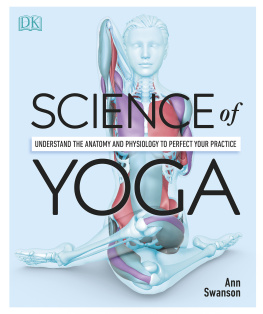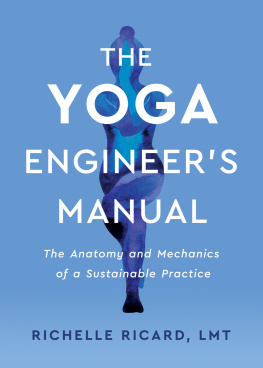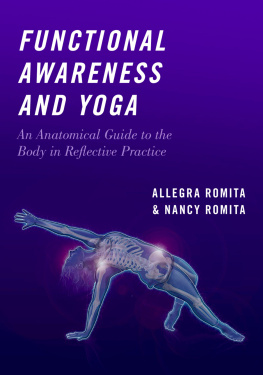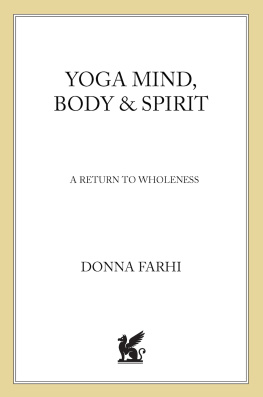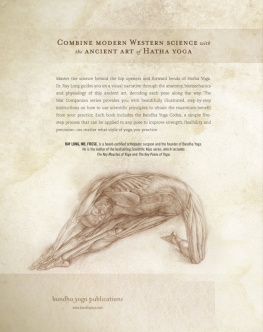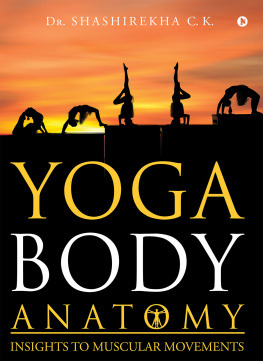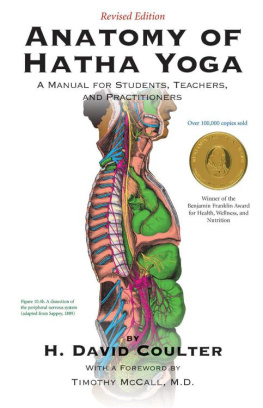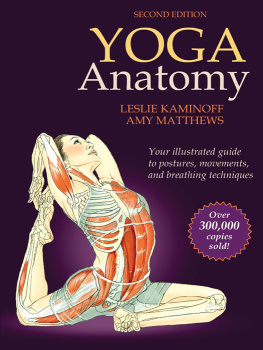
Functional Anatomy of Yoga
A Guide for Practitioners and Teachers
David Keil

Healing Arts Press
One Park Street
Rochester, Vermont 05767
www.HealingArtsPress.com
Healing Arts Press is a division of Inner Traditions International
Copyright 2014, 2022 by David Keil
Originally published in the United Kingdom in 2014 by Lotus Publishing
All rights reserved. No part of this book may be reproduced or utilized in any form or by any means, electronic or mechanical, including photocopying, recording, or by any information storage and retrieval system, without permission in writing from the publisher.
Note to the reader: This book is intended as an informational guide. The remedies, approaches, and techniques described herein are meant to supplement, and not to be a substitute for, professional medical care or treatment. They should not be used to treat a serious ailment without prior consultation with a qualified health care professional.
Cataloging-in-Publication Data for this title is available from the Library of Congress
ISBN 978-1-64411-627-2 (print)
ISBN 978-1-64411-628-9 (ebook)
Printed and bound in India by Replika Press Pvt. Ltd.
10 9 8 7 6 5 4 3 2 1
Anatomical Illustrations Amanda Williams and Emily Evans
Photographs Jose Caban
Text Design and Layout Medlar Publishing Solutions Pvt. Ltd., India
To send correspondence to the author of this book, mail a first-class letter to the author c/o Inner Traditions Bear & Company, One Park Street, Rochester, VT 05767, and we will forward the communication, or contact the author directly at .
Contents
Acknowledgments
There are many people who have been a part of making this book possible. First and foremost is my wife who has put up with me quitting the task, picking it up again, and all the complaining that happened until I finally got it done. Secondly, is my publisher, who is extremely patient, and put up with me going way over the deadline. Third, is my final editor Eryn Kirkwood, who did a fantastic job of helping me convey the subject clearly.
The book wouldnt be in your hands right now if a series of events hadnt happened in just the right order at just the right time.
I must say a very special thanks to Iris Burman and the staff that supported me at Educating Hands School of Massage in Miami, Florida. Without their support, guidance and ultimately tossing me into the deep end to start teaching, I would not have honed my skills as a teacher. It was also at Educating Hands that I met my first mentor in bodywork, Nick Chitty. His guidance, friendship, and mentoring propelled my work to the next level.
My very first anatomy workshop for yoga students would not have happened if not for Karen Schachter who in 2000 asked me to teach a group of her friends at a local yoga studio. My very first hosts were Ryan Spielman and Marisa Gallardo at Yoga Grove in Miami, Florida.
The real work of understanding my anatomy was through the practice of yoga. For that I had to meet John Scott and his wife Lucy Scott in 2001. If I had not met them I would never have made it to Mysore, India. It was there that I met Sri K. Pattabhi Jois and his grandson Sri R. Sharath. It was John and Lucys guidance of my practice and the discipline that I found in Mysore that pushed me deeper into my own practice. This depth and focus helped me to understand my anatomy, especially as it related to yoga.
Beyond that, there have been countless studios that have warmly welcomed me to be part of their teacher training programs and present anatomy to their students. All of them have helped to get this book into your hands as well. Without the questions, comments, or looks of utter confusion from these students, I would not have refined my teaching. After all, we always grow through relationship. With great thanks to all of these students, I appreciate your feedback and interactions.
Last, but certainly not least, is the assistance from everyone here at Yoganatomy.com. A very special thank you to, Christine Wiese, Amy Dolan, Aaron Segall, and Guy Andefors.
Foreword
In 2001 David arrived at our yoga studio in Penzance, Cornwall, UK, to work with Lucy and myself, in developing his Ashtanga Vinyasa yoga practice. David had been practicing asana (yoga postures) for some time, but it was obvious that he was not breathing or using bandha (subtle body controls) correctly or efficiently; he needed to refine his relationship and the balance between sthira (steady, still, and firm foundation) and sukha (good space). For the yogin (one who practices yoga), understanding sthira and sukha deepens the understanding of the relationship between posture, gravity, and breath and for the anatomist who practices asana , discovering sthira and sukha will bring understanding of the structure, function, breath and movement of the human body to a whole new level.
When we met David so many years ago, his immense understanding of anatomy and experience gained from teaching and working in the field of massage was also evident. He presented a short yoga anatomy workshop at our studio for local and visiting students who were practicing with Lucy and I. His animated delivery emphasized how remarkable the human body is. At the end of the evening, a local doctor who was participating said that in all her years of medical training and anatomy classes, this one session with David brought the body alive for her. Lucy, also an experienced body worker and massage therapist, was so impressed that she went straight to David and invited him to teach the anatomy for our yoga teacher trainings.
That evening was the beginning of a mutual journey of growth, with Lucy, David, and myself together exploring, discovering, having insights, and gaining first hand a new appreciation for this amazing body we inhabit. This journey with David will continue for years to come, and Im sure this will be the first of many books he will write.
The information in this book has not come from researching other books but from deep exploration on the yoga mat. David does not reduce the body to mere parts. For practical reasons, the work is divided into chapters, but at all times, David maintains a wider perception, holding the body as a unified living, breathing, moving organism. He takes anatomy to a whole new level.
As with other anatomy texts, David references body parts with anatomical words and descriptions; however, he goes further. Using his own experience with yoga asana , putting his own body into the many gravity-defying structures, he creates an understanding for you, the reader, in everyday language. This book is a bridge across the gap between the professional academic and the self-exploring yoga student. You, too, will gain a personal understanding and insight by taking Davids gems of wisdom to your yoga mat, and through your own personal practical exploration, will connect all separated parts into one whole functioning and breathing body, alive steady in asana sthira/sukha .
It is an honor and a pleasure to write a foreword to this exploratory journey into the functioning of the physical body. When I read through Davids draft, I could hear his voice, the complexity yet simplicity of the presentation. It felt as though I was present in one of his workshops, eager to be led by David through the practical anatomical exercise on the yoga mat. This book is a journey of deep exploration that will enhance each individuals understanding of what it really means to inhabit a body that not only stands in anatomical neutral, samasthitih , but also moves with the breath to create asana . A body that shape shifts towards the postural understanding of our bodies, tension free, relaxed, still, and steadygracefully moving in space, mastering the relationship of posture, breath, and gravity.
Next page
